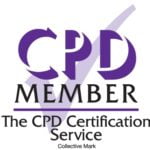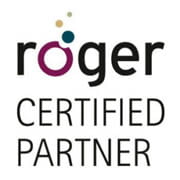Protecting your hearing is essential for maintaining your overall health and quality of life. Whether you’re exposed to loud noises at work, enjoy attending concerts, or need to keep your ears safe while swimming, using the right protection can make a significant difference.
Exposure to loud noise can lead to permanent hearing loss, affecting your ability to communicate and enjoy everyday sounds. Activities such as listening to loud music, attending concerts, and even certain jobs and hobbies can gradually damage your hearing. That’s why it’s crucial to understand the importance of hearing protection and choose the right solutions for your needs.
In this guide, we’ll explore everything you need to know about hearing protection. From understanding the different types available and their benefits, to choosing the right protection for various activities, we’ve got you covered. We’ll also share tips on maintaining your hearing protection devices and address common questions and misconceptions.
In This Article:
-
- What Is Ear Protection?- What Is Ear Protection?
-
- Why Do You Need Ear Protection?- Why Do You Need Ear Protection?
-
- Types of Ear Protection- Types of Ear Protection
-
- Instant-Fit vs. Custom-Fit Ear Protection- Instant-Fit vs. Custom-Fit Ear Protection
-
- Benefits of High-End Ear Protection- Benefits of High-End Ear Protection
-
- Which Type of Ear Protection Is Right for Me?- Which Type of Ear Protection Is Right for Me?
-
- How to Properly Use and Maintain Ear Protection- How to Properly Use and Maintain Ear Protection
-
- Innovations in Ear Protection Technology- Innovations in Ear Protection Technology
Understanding Ear Protection
1) What Is Ear Protection?
Ear protection refers to devices and practices designed to reduce the risk of hearing damage caused by exposure to loud noise. Here are the main types of hearing protection:
- Earplugs: These small devices fit directly into your ear canal to block out noise. They come in various forms, including foam and silicone.
- Earmuffs: These cover the entire outer ear to reduce noise levels and are often used in industrial settings or by people exposed to loud noises regularly.
- Custom-Fit Devices: Tailored to fit your ears perfectly, these provide a comfortable and effective seal. They’re popular among musicians, swimmers, shooters, and those in noisy work environments.
2) Why Do You Need Ear Protection?
Using hearing protection is crucial because it helps prevent noise-induced hearing loss (NIHL), which happens when loud sounds damage the delicate structures in your inner ear:
- Risk of Loud Noise Exposure: Loud noises can damage the hair cells in your inner ear, leading to permanent hearing loss. This can happen after long-term exposure to sounds above 85 decibels (dB).
- Irreversible Damage: Unlike some other forms of hearing loss, noise-induced hearing loss is permanent and cannot be reversed. Once the hair cells in the inner ear are damaged, they do not regenerate.
- Impact on Quality of Life: Hearing loss can make communication difficult, affect your work performance, and reduce your enjoyment of everyday activities. It can also lead to social isolation and mental health issues like depression and anxiety.
3) Statistics on Hearing Loss Due to Noise Exposure
- How Common Is NIHL? Over 1 billion young people worldwide are at risk of hearing loss due to unsafe listening practices, according to the World Health Organisation (WHO).
- Noise at Work: About 17,000 people in the UK suffer from deafness, tinnitus or other ear conditions as a result of exposure to excessive noise at work (HSE).
- Long-Term Effects: People with untreated hearing loss are thought to be under higher risk of cognitive decline and dementia, underlining the importance of early prevention and intervention.
Using the right hearing protection can help prevent these issues, keeping your hearing healthy for years to come. Make sure to choose the protection that best suits your needs and use it consistently in noisy environments.
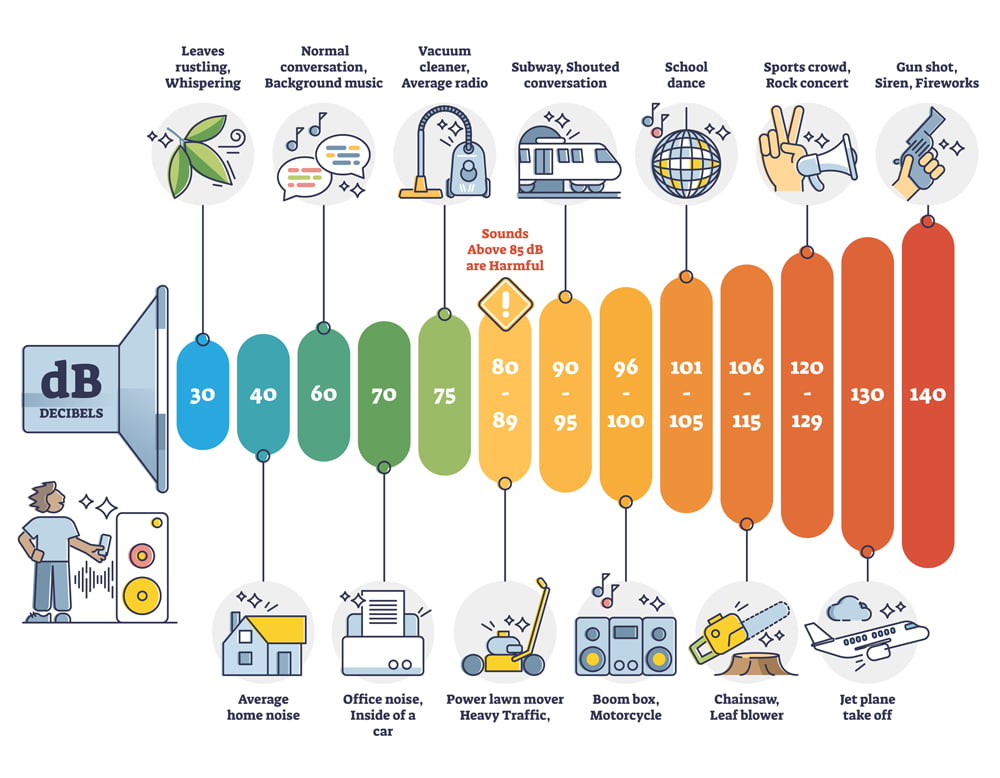
Types of Ear Protection
1) Ear Protection for Musicians
Musicians are frequently exposed to high levels of sound that can cause long-term hearing damage. Proper hearing protection is essential to safeguard their hearing while preserving the quality and clarity of music:
- Musician Earplugs: These earplugs are designed to reduce sound levels evenly across frequencies, maintaining the integrity of the music. Custom musician earplugs can offer different levels of attenuation.
- In-Ear Monitors (IEMs): IEMs provide both hearing protection and a personalised audio mix, allowing musicians to hear themselves and other instruments clearly without the need for loud stage monitors.
2) Ear Protection for Shooters and Hunters
The loud noise from gunfire can cause permanent hearing damage, making proper hearing protection crucial for shooters and hunters:
- Electronic Earplugs: These earplugs provide active noise cancellation and amplification of ambient sounds, allowing for communication while protecting from sudden loud noises.
- Custom Shooter Earplugs: Tailored to fit the shooter’s ear perfectly, these provide maximum protection and comfort.
3) Ear Protection for Professionals
In many occupations, such as construction and manufacturing, high levels of noise can contribute to hearing loss over time. Prolonged exposure to loud environments can cause permanent damage to your hearing. Here are some solutions:
- Earplugs and Earmuffs: Depending on the noise level and duration, workers can use earplugs, earmuffs, or a combination of both for maximum protection.
- Custom-Fit Occupational Earplugs: These provide a tailored fit for comfort during long work hours and ensure a proper seal to block out harmful noise.
4) Ear Protection for Swimmers
Swimmers often face the risk of ear infections caused by water entering the ear canal. Prolonged exposure to water can lead to conditions like swimmer’s ear, which can be painful and disruptive. Solutions include:
- Swimmer’s Earplugs: These are designed to keep water out of the ears while swimming, preventing infections and discomfort.
- Custom Swim Moulds: Custom-made to fit the swimmer’s ear perfectly, these provide a watertight seal and are comfortable for extended use.
Using the right type of hearing protection for your specific needs is essential to prevent hearing damage and maintain your overall ear health. Whatever your specific circumstances, there are tailored solutions available to keep your ears safe.
Instant-Fit vs. Custom-Fit Ear Protection
1) Instant-Fit Ear Protection
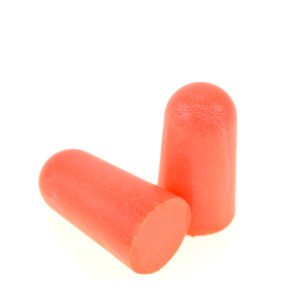
Instant fit earplugs and earmuffs are readily available, off-the-shelf solutions that can be used immediately. They come in various sizes and materials, such as foam, silicone, and plastic.
Pros:
- Accessibility: Easily found in stores and online.
- Affordability: Generally less expensive that custom-fit options.
- Convenience: No need for an appointment or waiting period; they can be used right away.
Cons:
- Fit: May not provide a perfect fit, leading to potential discomfort or less effective noise reduction.
- Durability: Often less durable and may need frequent replacement.
2) Custom-Fit Ear Protection
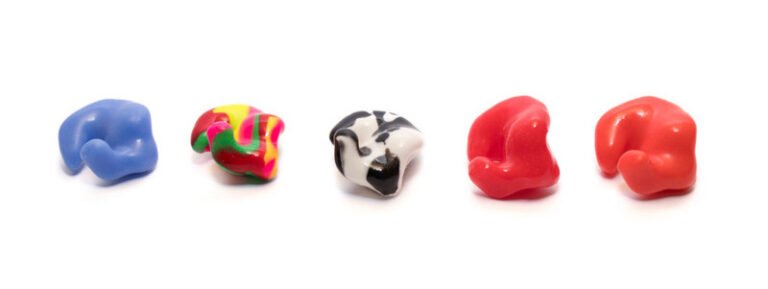
Custom-fit earplugs are tailored to the individual’s ear shape, usually requiring a visit to an audiologist or specialist for moulds to be taken.
Pros:
- Perfect Fit: Designed to fit the unique contours of your ears, providing maximum comfort and effectiveness.
- Durability: Typically made from high-quality materials that last longer.
- Effectiveness: Better noise reduction due to the precise fit, which ensures a proper seal.
Cons:
- Cost: More expensive than instant fit options.
- Accessibility: Requires an appointment and a waiting period for the custom devices to be made.
Benefits of High-End Ear Protection
1) Reduced Harmful Noise
High-quality hearing protection is designed to significantly reduce harmful noise levels, protecting your ears from potential damage. Unlike standard hearing protection, high-quality options use advanced materials and technologies to provide superior noise reduction. This helps to:
- Prevent Hearing Loss: By reducing exposure to loud noises, high-quality hearing protection prevents the damage to the inner ear’s delicate structures, such as hair cells.
- Improve Focus: In noisy environments, excessive noise can be distracting and stressful. Effective hearing protection reduces this noise, allowing you to concentrate better on tasks without the constant interference of loud sounds.
- Enhance Safety: In environments like construction sites or factories, reducing harmful noise helps prevent hearing damage while still allowing for awareness of important warning signals and communication.
2) Improved Communication in Noisy Settings
One of the standout benefits of high-quality hearing protection is the ability to reduce harmful noise while still allowing essential communication. This is achieved through advanced filter technology, which can:
- Reduce Noise Selectively: Advanced filters can differentiate between harmful noise and important sounds, such as human speech. This allows users to hear conversations and important alerts without removing their hearing protection.
- Improve Speech Clarity: High-quality hearing protection can enhance speech clarity by reducing background noise, making it easier to communicate in noisy environments like construction sites, music concerts, or crowded workplaces.
3) Superior Comfort and Durability
Comfort and durability are essential features of high-quality hearing protection, especially for individuals who need to wear these devices for extended periods of time. High-quality hearing protection offers:
- Custom Fit: Custom-fit hearing protection devices are moulded to the unique shape of your ears, ensuring a perfect fit that stays comfortable all day long. This reduces the irritation and discomfort sometimes associated with generic earplugs or earmuffs.
- Breathable Materials: Many high-quality hearing protection devices use materials that are both durable and breathable, preventing moisture buildup and ensuring long-term comfort.
- Longevity: High-quality hearing protection is built to last. They are often made from robust materials that withstand wear and tear, making them a cost-effective investment over time. Unlike disposable earplugs, custom-fit devices and high-end earmuffs can last for years with proper care.
- Maintenance and Hygiene: High-quality hearing protection is easier to clean and maintain, reducing the risk of ear infections and ensuring optimal performance over time.
Investing in high-quality hearing protection not only safeguards your hearing but also enhances your overall experience in noisy environments, ensuring both comfort and effective communication.
Which Type of Ear Protection Is Right for Me?
When selecting ear protection, it’s essential to consider several factors to ensure you get the best efficiency for your needs:
1) Noise Level of the Environment
Assess the typical noise levels you are exposed to. For instance, industrial environments can reach around 85-100 decibels (dB), concerts often exceed 100 dB, and shooting ranges can reach 140 dB or more. Understanding these levels will help you choose the appropriate protection. In industrial environments (85-100 dB), earplugs or earmuffs with an NRR (Noise Reduction Rating) of 20-30 dB are recommended. For concerts (100+ dB), musicians’ earplugs or high-fidelity earplugs with an NRR of 15-25 dB are suitable to preserve sound quality while protecting your hearing. At shooting ranges (140+ dB), electronic earplugs or earmuffs with an NRR of 25-33 dB are ideal for reducing the impact of sudden, loud noises.
2) Duration of Exposure
Consider how long you’ll be exposed to loud noises. Continuous exposure to loud sounds, even at lower levels, can be as damaging as short bursts of extremely loud noise. If you are in a noisy environment for extended periods, you will need comfortable and effective hearing protection that you can wear all day without discomfort.
3) Personal Comfort and Fit
Comfort and fit are crucial for ensuring you wear the hearing protection consistently. Ill-fitting earplugs or earmuffs can be uncomfortable and less effective. Look for hearing protection that fits well and feels comfortable, especially if you need to wear it for long periods.
4) Your Individual Needs and Preferences
Custom hearing protection can be tailored to your needs and preferences. For example, musicians might require earplugs that reduce noise evenly across all frequencies to preserve the quality of the music, while industrial workers might need maximum noise reduction. Custom options also include features like filters that allow for communication while still blocking harmful noise levels.
How to Properly Use and Maintain Ear Protection
1) Tips for Using Earplugs and Earmuffs Correctly
- Inserting Earplugs: Roll the earplug between your fingers to compress it, then gently insert it into your ear canal. Hold it in place for a few seconds until it expands to fill the space. Make sure it’s snug but not uncomfortable.
- Wearing Earmuffs: Ensure that the earmuffs fully cover your ears and form a tight seal against your head. Adjust the headband so that it fits comfortably without being too loose or tight.
2) Maintaining Your Ear Protection Devices
- Cleaning Earplugs: Wash reusable earplugs with mild soap and warm water after each use. Allow them to dry completely before storing them in a protective case.
- Cleaning Earmuffs: Wipe down the ear cups and headband with a damp cloth. Avoid using harsh chemicals that could damage the materials.
- Storage: Store your hearing protection devices in a cool, dry place away from sunlight and extreme temperatures. Keep them in a protective case to prevent dirt and damage.
- Regular Inspection: Regularly inspect your hearing protection for signs of wear and tear. Replace any damaged or worn parts to ensure they continue to provide effective noise reduction.
Innovations in Hearing Protection Technology
1) Latest Advancements
- New Materials: Advances in the materials being used have led to the development of more effective and comfortable hearing protection devices. For example, memory foam earplugs provide a better seal and more comfort than traditional foam.
- Smart Hearing Protection: Some modern hearing protection devices come equipped with smart technology, such as Bluetooth connectivity and environmental awareness modes that adjust the level of noise reduction based on your surroundings.
- Custom-Fit Technology: Advances in 3D printing and scanning technologies have made it easier to create custom-fit earplugs.
2) Emerging Trends in the Industry
- Integration with Communication Devices: Many new hearing protection devices are designed to integrate seamlessly with communication systems, making them ideal for use in industrial and military applications.
- Eco-Friendly Options: There is a growing trend towards eco-friendly hearing protection products made from sustainable materials and designed for long-term use.
- Increased Awareness and Education: More people are becoming aware of the importance of hearing protection, leading to increased demand for high-quality products are educational initiatives to promote hearing health.
With so many advancements and options available today, there’s a perfect hearing protection solution for just about everyone’s needs. Regardless of the activity you need hearing protection for, you’re sure to find a device that offers both comfort and efficiency.
Conclusion
Protecting your ears and hearing is essential for maintaining your overall wellbeing and quality of life. Take a moment to consider your specific ear protection needs and take proactive prevention steps. Whether you’re exposed to loud noises at work, during recreational activities, or in everyday environments, using the right ear protection can make a significant difference. Effective solutions not only prevent permanent hearing damage but also enhance your ability to communicate and stay engaged in your daily activities. By choosing appropriate ear protection, you can ensure that you continue to enjoy the sounds of life without compromise. Remember, taking action now can help preserve your hearing health for the future.
Hear4U's Range of Ear Protection Solutions
At Hear4U, we provide a wide selection of hearing protection solutions to meet all your needs. Whether you need off-the-shelf options to use straight away or bespoke, custom-made protection, we’ve got you covered. With our comprehensive range, you can find the ideal hearing protection for any situation. If you’d like to learn more about our products and how they can benefit you, click the button below to get in touch.



